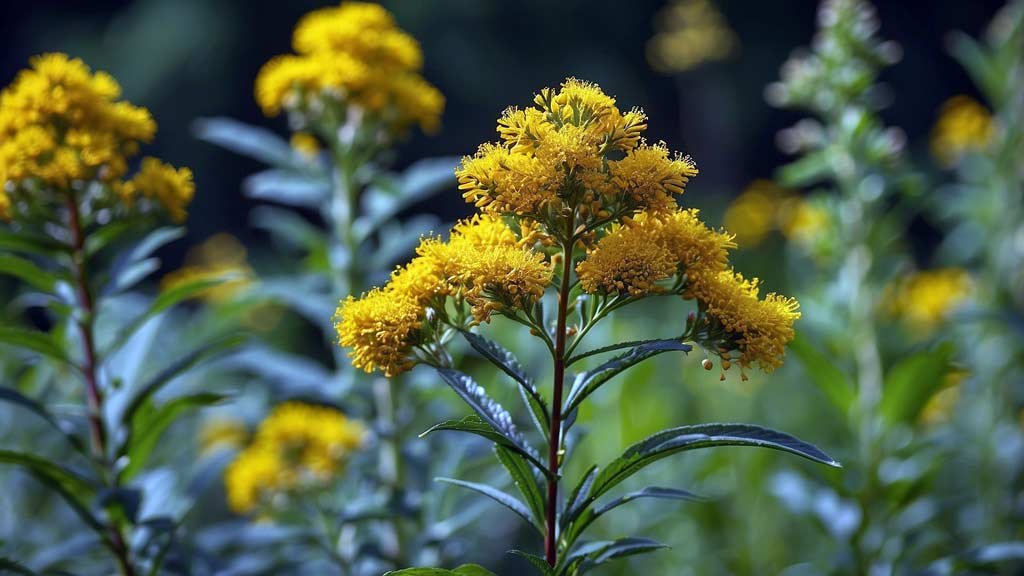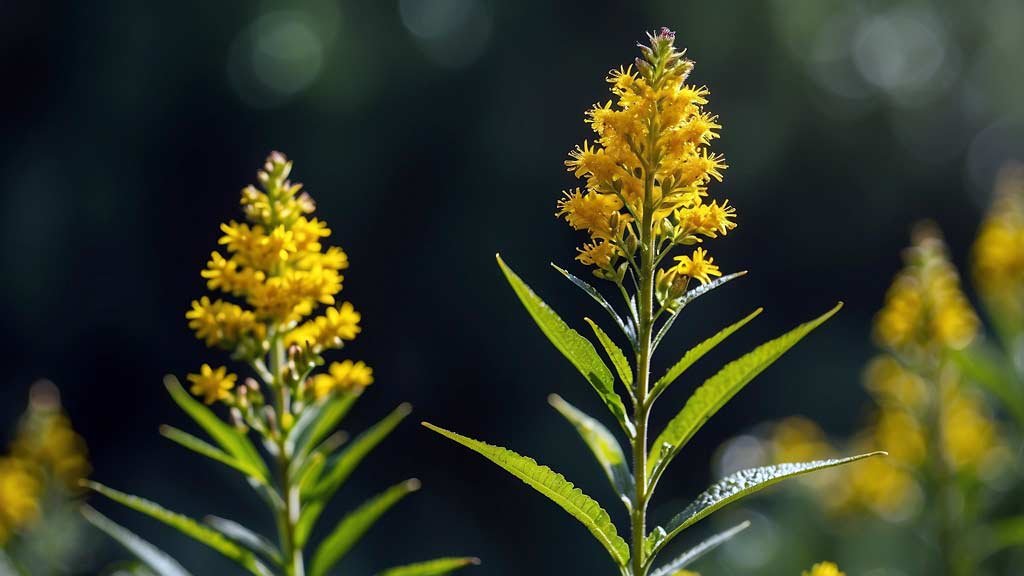A Bright Yellow Plant With a Quiet Reputation
Goldenrod (Solidago spp.) doesn’t get the respect it deserves. Too often, it’s unfairly blamed for seasonal allergies because it blooms at the same time as ragweed, which actually produces the sneaky windborne pollen that makes people sneeze. Goldenrod’s pollen is sticky and insect-pollinated—it rarely makes it into the air. So, the poor plant takes the fall while quietly offering centuries of herbal support for kidneys, urinary health, allergies, and more.
You’ll see goldenrod standing proud in fields, roadsides, and open meadows, tall stalks topped with bright clusters of yellow flowers. Native Americans brewed it as tea. European settlers carried the seeds back across the Atlantic, where it became a staple in traditional remedies. Its name itself—Solidago—means “to make whole” in Latin. That’s a clue about how people once viewed its healing nature.
Table of Contents
Goldenrod and Kidney Health
Goldenrod has earned a strong place in herbal traditions as a kidney ally. The plant is considered a mild diuretic, helping the body increase urine flow without harsh side effects. More urine flow means the kidneys get a gentle “flushing,” which can support cleansing and reduce the chance of things stagnating in the urinary tract.
Why Goldenrod Helps the Urinary System
Goldenrod contains a mix of flavonoids, saponins, and phenolic glycosides. These compounds are believed to:
- Encourage water excretion while balancing electrolyte levels
- Reduce inflammation in urinary tissues
- Offer antimicrobial support against bacteria that sometimes trigger urinary tract infections
- Help reduce discomfort linked to kidney stones by easing muscle spasms in the urinary tract
It’s not magic—it’s more like a steady, helpful nudge. For someone who tends toward fluid retention or mild urinary discomfort, a tea made from goldenrod can feel like a relief.
A Cup of Tea for the Kidneys
If you’ve ever tasted goldenrod tea, you know it’s earthy with a slight sweetness, a little like honey mixed with hay. You sip it and feel that gentle urge to use the bathroom a little more often. It doesn’t hit like coffee. It’s calmer, steadier. That’s one of the reasons herbalists often recommend it for urinary support after infections or to help the body clear lingering irritation.
Goldenrod for Allergies and Seasonal Relief
Here’s the twist—while many folks blame goldenrod for allergies, herbalists actually use it to ease them. Its astringent and anti-inflammatory actions can help calm swollen sinuses, soothe sore throats, and even dry up a drippy nose.
Goldenrod and Hay Fever Relief
Goldenrod contains quercetin, a flavonoid with natural antihistamine properties. Antihistamines block the release of histamine, the chemical your body pumps out when reacting to allergens. By doing so, goldenrod may help:
- Reduce sneezing fits
- Calm watery eyes
- Ease sinus pressure
- Shorten the duration of allergy flare-ups
Of course, goldenrod isn’t going to replace every antihistamine pill on the market, but for some, it offers a gentler option that doesn’t come with drowsiness.
Breathing Easier
Goldenrod tea or tincture can also support the respiratory system during seasonal shifts. The plant’s natural drying effect helps reduce excess mucus. Imagine going from feeling like your head is stuffed with wet cotton to breathing freely again—that’s the kind of subtle relief goldenrod offers when used consistently.
A Broader Look at Goldenrod’s Benefits
Beyond kidneys and allergies, goldenrod has found its way into many traditional uses. Some are backed by research, others more by folk wisdom. Either way, the plant has versatility that keeps it valuable.
Anti-inflammatory Support
Goldenrod has been used topically for muscle aches, arthritis stiffness, and sore joints. Its compounds can help reduce inflammation and improve blood flow in affected areas. A goldenrod-infused oil massaged into tired muscles can feel like warmth spreading slowly through tension.
Antimicrobial Properties
The plant’s essential oils contain antimicrobial activity. Traditionally, people applied goldenrod poultices on wounds or skin irritations. Today, some herbalists still recommend washes or compresses made from goldenrod for minor skin issues.
Digestive Aid
Goldenrod tea sometimes helps with bloating and indigestion. Its mild bitterness stimulates digestive juices, encouraging smoother processing of food. It’s not as strong as gentian or wormwood, but it’s a friendly herb for people who want digestive support without harsh intensity.

How to Use Goldenrod
Goldenrod is easy to prepare in different forms, and most people tolerate it well.
Tea
- Use 1–2 teaspoons of dried flowering tops per cup of hot water.
- Steep 10–15 minutes.
- Drink up to 3 cups daily for urinary or allergy support.
Tincture
- Typical dosage: 2–4 ml, up to three times daily.
- Convenient if you don’t have time to brew tea.
Infused Oil or Compress
- For sore muscles or skin irritation, soak a cloth in goldenrod tea and apply it warm.
- Or massage the infused oil directly into the area.
Safety Notes
Goldenrod is generally safe, but there are a few exceptions:
- Avoid if you have severe kidney disease without medical supervision.
- Allergic reactions are rare but possible, especially for people sensitive to plants in the Asteraceae family (like daisies and ragweed).
- Pregnant or breastfeeding women should check with a practitioner before use.
Growing and Harvesting Goldenrod
If you’ve got a patch of land, goldenrod practically grows itself. It loves full sun and average soil, often spreading on its own. Some gardeners consider it invasive, but if you’re harvesting regularly, it’s easy to manage.
Harvest when the flowers are bright yellow, usually late summer. Cut the top third of the plant, bundle, and hang to dry in a warm, airy spot. Once dry, store in a jar away from light. The flowers hold their color beautifully, a little reminder of summer even in the cold months.
A Plant That’s Misunderstood but Mighty
Goldenrod deserves a place in the herbal medicine cabinet. It’s not the villain behind sneezing fits—it’s a quiet helper for the kidneys, a relief for sinuses, a soother for sore muscles. Think of it as that reliable friend who never steals the spotlight but always shows up when you need a hand.
The next time you see goldenrod swaying in a field, don’t curse it. Maybe stop for a moment, notice how its yellow seems to glow against late-summer skies, and remember that inside those bright blossoms lies centuries of wisdom for health and healing.
Article Sources
At AncientHerbsWisdom, our content relies on reputable sources, including peer-reviewed studies, to substantiate the information presented in our articles. Our primary objective is to ensure our content is thoroughly fact-checked, maintaining a commitment to accuracy, reliability, and trustworthiness.
- Blumenthal, M., Goldberg, A., & Brinckmann, J. (2000). Herbal Medicine: Expanded Commission E Monographs. Newton, MA: Integrative Medicine Communications.
- European Medicines Agency. (2016). Assessment report on Solidago virgaurea L., herba. Retrieved from https://www.ema.europa.eu
- Gorzalczany, S., Filip, R., Alonso, M. R., & Ferraro, G. (2013). Antiinflammatory effect of Solidago chilensis Meyen on carrageenan-induced pleurisy in mice and its mechanisms of action. Journal of Ethnopharmacology, 145(1), 145–148. https://doi.org/10.1016/j.jep.2012.10.024
- National Center for Complementary and Integrative Health. (2020). Herbs at a Glance: Goldenrod. Retrieved from https://www.nccih.nih.gov
- Newall, C. A., Anderson, L. A., & Phillipson, J. D. (1996). Herbal Medicines: A Guide for Healthcare Professionals. London: Pharmaceutical Press.
- U.S. Department of Agriculture, Natural Resources Conservation Service. (2021). Solidago virgaurea L., European goldenrod. Retrieved from https://plants.usda.gov
- Wichtl, M. (2004). Herbal Drugs and Phytopharmaceuticals: A Handbook for Practice on a Scientific Basis (3rd ed.). Boca Raton, FL: CRC Press.

